Supporting evaluation components of Lake Huron Technical Committee’s cisco reintroduction study: a multi-agency effort to promote cisco recovery in the western main basin of Lake Huron (FY21)
Contributing Authors
Jose Bonilla-Gomez (USFWS, jose_bonillagomez@fws.gov), Kevin McDonnell (USFWS), Timothy O’Brien (USGS), Amanda Ackiss (USGS)
Executive Summary
The U.S. Fish and Wildlife service conducted larval coregonine surveys in 2021 aimed at documenting the current distribution, composition, and density of the larval coregonid community in Saginaw Bay. Sampling of the ichthyoplankton community was limited to pelagic neuston net tows and beach seining due to the funding and logistic limitations. Pelagic ichthyoplankton surveys were conducted weekly at 40, randomly selected, spatially balanced, depth stratified sites throughout Saginaw Bay from March 29th – April 16th, 2021. During each ichthyoplankton sample larvae were sampled within 1m of the surface using a 500-µm, 2 x 1m neuston net. Larval coregonine were present in each depth bin >3m throughout the entire Bay in six weeks of sampling. Observed Larval coregonid densities of individual neuston tows ranged between 0 and 0.25 individuals/m3 with sampled coregonid larvae ranging between 12.79 and 24.24 mm in total length. Observed larval coregonid densities pooled across sampling weeks and depth bins indicated that densities were low during the sampling period and appeared to be a poor year for coregonid production in general (Fig. 1). We relied on meristics and morphology to differentiate larval Lake Whitefish and Cisco, which unfortunately proved to be difficult. The vast majority (>95%) of the total ichthyoplankton catch could not be reliably identified past the Coregonus genus. Approximately 229 larval coregonine from Saginaw Bay were made available for genetic sequencing, where no Cisco was detected, and all were Lake Whitefish confirmed. Following larval sampling, age0 coregonines were sampled using onshore beach seines as well as small mesh bottom trawls. Beach seining was done at 4 sites on both sides of Saginaw Bay (Tawas, AuGres, Caseville and Jenks Park). Beach seines (50 m in length, 3.175 mm mesh) were conducted between April 19th – May 14th, 2021 at each site. A total of 36 young of year lake whitefish (mean total length 28.6 mm) were sampled during the sampling in Saginaw Bay. Unfortunately, no other coregonine were observed during any of the other beach seines. Bottom trawl (7.62m headrope, 3.175mm cod end mesh) sampling was limited to only Tawas Bay due to logistics and access to suitable sampling substrate in Saginaw Bay. Trawls were conducted weekly from April 19th to May 14th, 2021 and were all done within 24 hours of beach seine sampling at Tawas Beach (Fig. 3). Each week two trawls were completed along depth contours at 3 different depth strata (eight total weekly trawls): 1-3m, 3-6m, and 6-9m. An additional two tows were done across depth contours (e.g. 1-9m). All trawls (total n = 16) were 5 minutes in total length and were conducted over sandy or gravel substrate during the daylight. Unfortunately, our trawl sampling failed to capture any coregonids. We were unable to perform acoustic surveys in Saginaw Bay in 2020 due to covid protocols and unforeseen staff turnover. However, in August 2021 Lake Huron acoustic survey (hydroacoustic transects and midwater trawls) was made by Michigan DNR to assess post-stocking survival of Cisco, but no Cisco was captured. Additionally, in the fall of 2021 we implemented a spawning gill net survey to sample spawning adults for the first time in Saginaw Bay. In fall of 2021 was the first year that the first-year class of stocked Cisco may have reached maturity (age 3), assuming the 2018-year class survived and successfully spawned in Saginaw Bay. Unfortunately, due to weather and unusually warm water temps we were only able to sample for 2 nights in October of 2021. Overnight gill nets were set on rocky habitat adjacent to the shore stocking location at the end of Bessinger Road just north of Point Lookout and in other sites along the bay (Fig. 2). To confirm their hatchery origin and release season of all Cisco caught in Saginaw Bay during the fall spawning survey, we used a methodology of detection with florescence microscopy, where all specimens were evaluated for the presence of oxytetracycline (OTC) markers in the vertebras of the caudal peduncle (Fig. 3). Each vertebra was exposed under a stereoscope (8-40X magnification) with an ultraviolet light (~365 nm) between 3 and 6 minutes in the centrum area in a cross-section position. Despite a limited initial effort, a total of 3 hatchery origin (OTC spring release confirmed) mature male Cisco were sampled.
Outcomes
All sampling outlined for FY2020 was delayed due to covid-19 and was carried out in FY2021 instead, samples from those surveys were processed and monitored larval coregonid density and composition throughout Saginaw Bay in 2021
Performed beach seine surveys near previous Cisco stocking locations
Samples of >200 larval coregonids were described with morphometric and meristic measurements to identify larval coregonid species in Saginaw Bay without the use of genetic techniques
Analyzed >200 larval coregonids for genetic-based species assignment, but no larval cisco detected
We developed a better understanding of the spatial and temporal variation inherent in the sampling of larval coregonines in Saginaw Bay
Developed sampling protocol for fall gillnet spawning survey of adult Cisco
Caught a total of 3 mature individuals of hatchery origin
